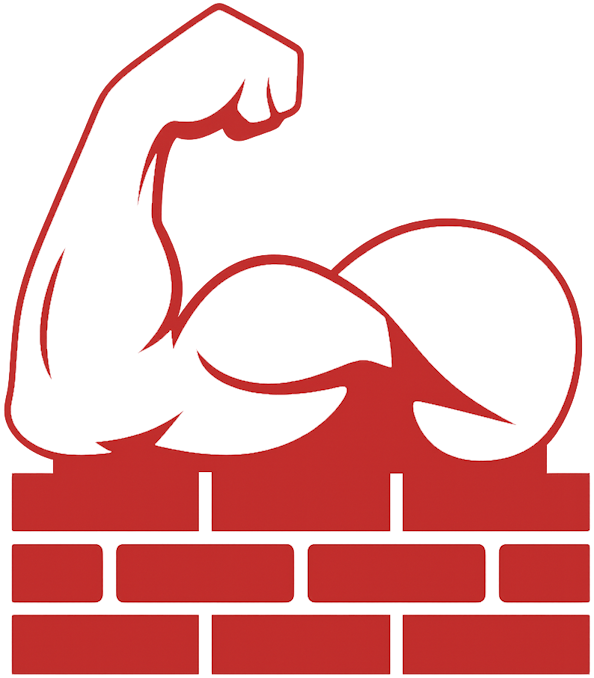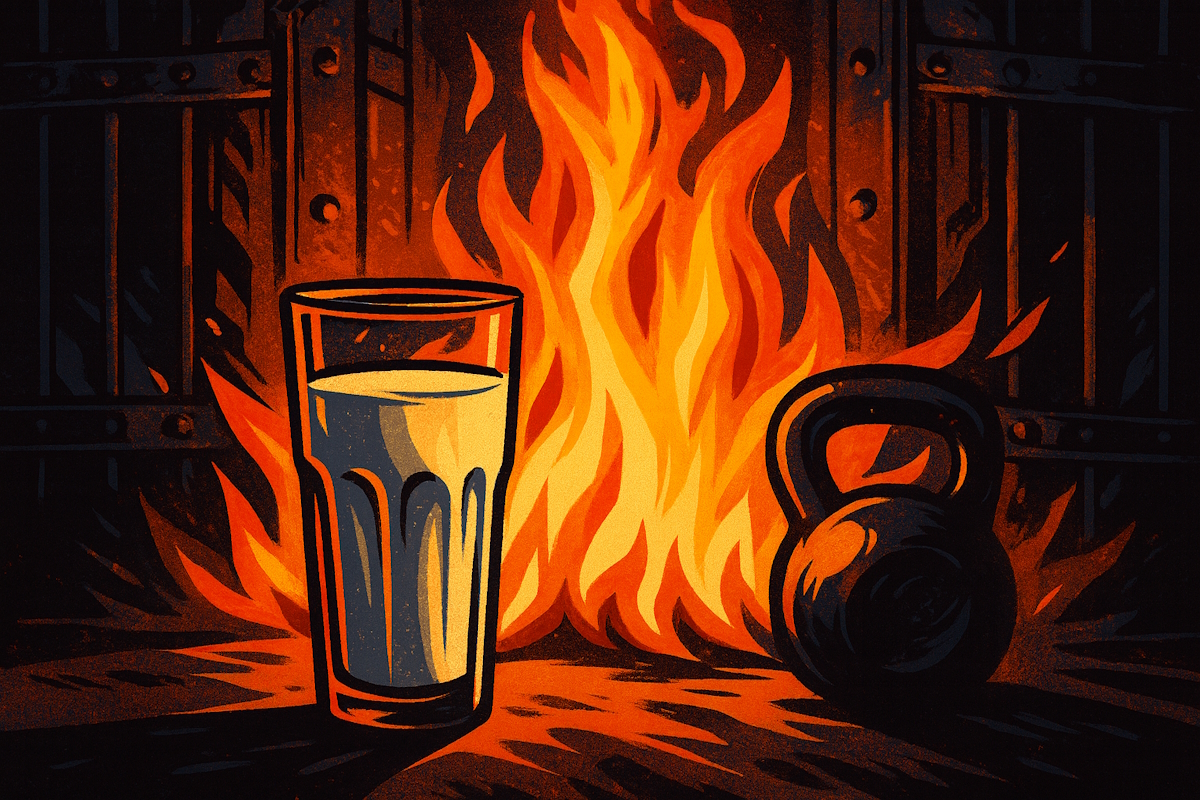From the Brickyard | Subject: The truth about milk and muscle
——
For decades, lifters have argued over the white jug.
Some call it nature’s protein shake.
Others call it bloating in a bottle.
So what’s the truth, brother?
If you’re chasing muscle, performance, and power—you’ve gotta know what’s fueling your engine.
Is milk helping you build size and strength…or holding you back?
The Case For Milk: Nature’s Recovery Drink
Milk’s been a bodybuilding staple since the golden era—Reeves, Park, and Gironda swore by it.
And they weren’t wrong.
Protein Power
Milk delivers two elite proteins: casein and whey.
- Whey digests fast — a post-lift amino acid flood.
- Casein digests slow — a drip-feed of muscle fuel for hours.
Together, they form a time-released muscle-growth combo that’s hard to beat.
Research published in The American Journal of Clinical Nutrition (Hartman et al., 2007) found that men who drank milk after resistance training gained significantly more lean muscle than those who used soy or carbs—confirming what lifters have known for decades.
A single cup of whole milk gives you 8 grams of protein and a solid dose of leucine, the amino acid that flips the switch for muscle protein synthesis.
And if you’re wondering why that slow drip matters, classic research by Boirie et al. (1997) showed that casein keeps amino acid levels elevated for hours after ingestion—meaning milk doesn’t just feed your muscles fast, it feeds them long.
Calories for Mass
If you’re struggling to gain size, milk’s a quick calorie weapon.
Whole milk clocks in around 150 calories per cup, making it perfect for shakes and bulking phases.
The legendary GOMAD (Gallon of Milk a Day) protocol—insane? Maybe. Healthy? Probably not. Effective? Absolutely. It’s how many hard gainers finally broke through plateaus.
You’re getting calories, protein, fat, and micronutrients all in one jug. It’s not elegant, but it’s old-school—and it works.
Vitamins & Minerals
Milk’s not just macros—it’s minerals and muscle fuel.
- Calcium: builds bone and powers contraction.
- Potassium: restores balance and aids recovery.
- Vitamin D: supports testosterone and immune strength.
Let’s be real, brother—milk’s a nutrient-dense recovery weapon.
The Case Against Milk: Not All Gains Are Equal
But it’s not all presses and pulls…milk has its pitfalls.
Lactose Intolerance
Some brothers just don’t digest milk well.
If you get gas, bloating, cramping, or gut chaos, it’s not fuel—it’s friction.
Roughly two-thirds of the global population deals with some degree of lactose intolerance, according to Misselwitz et al. (2013).
The solution? Try lactose-free milk, aged cheese, or fermented dairy like Greek yogurt or kefir. They’re easier on digestion and still deliver the anabolic goods.
Insulin Spike
Milk spikes insulin because of its sugar (lactose) and fast-digesting whey content.
That’s fine post-workout, but if you’re constantly sipping milk, it can blunt fat loss and mess with hormone balance.
A study published in the British Journal of Nutrition (Hoyt, Hickey, and Cordain, 2005) showed that both whole and skim milk triggered a disproportionately high insulin response compared to their modest blood-sugar rise. In other words, milk acts more like a “hidden carb”, low on the glycemic index, but high on the insulinemic response chart.
So if you’re deep in a cut or trying to improve insulin sensitivity, treat milk as a post-workout weapon—not an all-day sip. Timing is everything, brother.
Estrogen Concerns
Some worry about estrogenic compounds in conventional dairy.
But most data doesn’t back the fear.
A 2010 analysis by Pape-Zambito and colleagues found that the levels of 17β-estradiol in cow’s milk were far too low to meaningfully affect testosterone in men.
That said, if you’re skeptical or just want cleaner inputs, go organic or grass-fed to play it safe.
Is Organic Milk Better?
You’ve seen it: the halo label, the price bump, the promise of purity.
But is it actually better…or just branding?
Fewer Hormones, Antibiotics, and Pesticides
A 2020 analysis published in Public Health Nutrition found that conventional retail milk contained residues of current-use pesticides and antibiotics, while organic milk samples showed little to none detected (O’Donnell et al., 2020).
That means fewer potential endocrine disruptors and less chemical baggage in your recovery fuel.
In short: if you want to reduce the chemical noise in your system, organic wins the purity test.
Better Omega-3 Profile
Here’s where organic pulls ahead.
A 2013 PLOS ONE study (Benbrook et al.) revealed that organic, grass-fed milk had roughly 50 percent more omega-3 fatty acids and a better omega-3 to omega-6 ratio than standard milk.
That’s huge for the Musclebuilder: omega-3s lower inflammation, support testosterone, and speed recovery.
You’ll pay more, but you’re investing in cleaner, stronger fuel.
Price Tag Reality
You’ll pay more for organic, but nutritionally the protein and calories are nearly identical.
For the budget-minded, regular whole milk still gets the job done.
For long-term health and optimal hormone balance, grass-fed organic is worth the upgrade if you can swing it.
Musclebuilder Application
How to deploy milk like a weapon—not a crutch:
- Post-Workout: 1–2 cups of whole milk or a milk-based shake for quick recovery.
- Before Bed: 1-2 cups for slow-digesting casein overnight.
- Bulking: Use it for calories and convenience.
- Cutting: Limit it or track tightly—milk calories add up fast.
- Sensitive gut? Go lactose-free, grass-fed, or swap for Greek yogurt.
Final Verdict: Friend or Foe?
Milk’s a friend—if it fits your mission.
✅ Trying to gain weight? Milk helps.
✅ Need a convenient protein boost? Milk delivers.
❌ Digestive issues? Swap or skip.
❌ Cutting phase? Watch intake.
You don’t need milk to build muscle—but if your body runs clean on it, milk can absolutely be part of your arsenal.
It’s not soft. It’s old-school fuel.
Use it with purpose.
Brick by Brick.
-Brickwall
Sources
Hartman, J. W., et al. “Consumption of Fat-Free Milk after Resistance Exercise Promotes Greater Lean Mass Accretion than Soy or Carbohydrate.” The American Journal of Clinical Nutrition, vol. 86, no. 2, 2007, pp. 373–381. https://pubmed.ncbi.nlm.nih.gov/17684208/
Boirie, Y., et al. “Slow and Fast Dietary Proteins Differently Modulate Postprandial Protein Accretion.” Proceedings of the National Academy of Sciences, vol. 94, no. 26, 1997, pp. 14930–14935. https://pubmed.ncbi.nlm.nih.gov/9405716/
Misselwitz, B., et al. “Lactose Intolerance: From Diagnosis to Correct Management.” World Journal of Gastroenterology, vol. 19, no. 42, 2013, pp. 7289–7301. https://pubmed.ncbi.nlm.nih.gov/24443063/
Hoyt, G., M. S. Hickey, and L. Cordain. “Dissociation of the Glycaemic and Insulinaemic Responses to Whole and Skimmed Milk.” British Journal of Nutrition, vol. 93, no. 2, 2005, pp. 175–177. https://pubmed.ncbi.nlm.nih.gov/15788109/
Pape-Zambito, D. A., et al. “Concentrations of 17β-Estradiol in Holstein Whole Milk.” Journal of Dairy Science, vol. 93, no. 6, 2010, pp. 2533–2540. https://pubmed.ncbi.nlm.nih.gov/17582116/
O’Donnell, A. M., et al. “Production-Related Contaminants (Pesticides, Antibiotics, and Growth-Hormone Residues) in Retail Conventional and Organic Milk.” Public Health Nutrition, vol. 23, no. 8, 2020, pp. 1412–1423. https://pubmed.ncbi.nlm.nih.gov/31238996/
Benbrook, C., et al. “Organic Production Enhances Milk Nutritional Profile through Grazing and Forage-Based Feeds.” PLOS ONE, vol. 8, no. 12, 2013, e82429. https://pubmed.ncbi.nlm.nih.gov/24349282/

